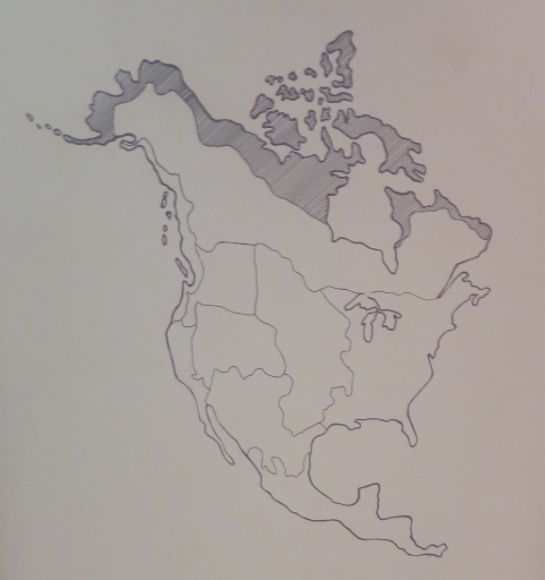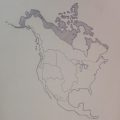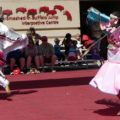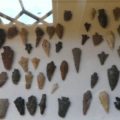The Artic Culture Area includes the Aleutian Islands, most of the Alaska Coast, the Canadian Artic, and parts of Greenland. It is an area which can be described as a “cold” desert. The area has long, cold winters and short summers. All of the aboriginal peoples in this cultural area are considered to be hunting and gathering people.
 The shaded area on the map shown above shows the Arctic culture area.
The shaded area on the map shown above shows the Arctic culture area.
The native people of the Artic are usually divided into the Aleut and the Eskimo. The Eskimo refer to themselves as Inuit and the Aleut call them themselves Unangan. All of the languages of this area are classified as Eskimoan.
For nomadic hunting and gathering people, transportation was important and the people living in the Arctic developed both boats and sleds. With regard to transportation in the Arctic, Bernard Saladin d’Anglure, writing about Quebec in the Handbook of North American Indians, reports:
“In Arctic Quebec perhaps more than anywhere else the Inuit developed and maintained their transportation system, one of the most original and efficient there has ever been.”
Bernard Saladin d’Anglure also reports:
“The combined use of umiak, kayaks, and dogs allowed bands of 20 to 30 people to move in summer along the coasts and the large water-courses with weapons and baggage.”
Thousands of years ago, the Inuit people living in the arctic developed a seaworthy craft which became known as the kayak. The kayak was simply a wooden frame covered with sealskin. There was a small hole to sit it and the tight fit between the user and the watercraft meant that it could be overturned and still float. The kayak, fast, light, seaworthy, was a hunting craft from which the hunter, armed with a deadly atlatl, could hunt seals and whales. Writing about the Canadian Inuit, Elman Service, in his book A Profile of Primitive Culture, reports:
“This craft, about the size of a small canoe, is probably the most seaworthy boat ever invented.”
 Shown above is a model of a kayak on display in the Maryhill Museum of Art.
Shown above is a model of a kayak on display in the Maryhill Museum of Art. 
 Shown above are two more kayak models on display at the Maryhill Museum of Art.
Shown above are two more kayak models on display at the Maryhill Museum of Art.
Among the Aleut, the kayak was called a baidarka. In his book The Native People of Alaska, Steve Langdon writes:
“One of their most impressive skills was the righting of a capsized baidarka while still in it.”
Carried in the kayak was a float made from a sea mammal stomach which provided support when righting an overturned boat. It also helped keep the boat afloat when taking on water.
In his Encyclopedia of Native American Tribes, Carl Waldman describes the baidarka this way:
“They were short, with the bow curved upward and the stern squared off. Sometimes the bows were shaped like a bird’s open beak. Usually there were two cockpits—one in back for the paddler and one in front for the harpooner.”
The Aleuts hunted sea mammals—sea otters, seals, whales, walruses, and sea lions—from kayaks. The harpooner in the front cockpit would use a throwing stick or atlatl which provided the harpoon with more power.
In addition to the kayak, the Aleut used a large open skin boats, the baidar, for travel and trade.
The Inupiat used a large open skin boat known as the umiak. Most of these boats were 15-20 feet long, but there are reports of some as long as 50 feet. The umiak was constructed by lashing seal skins to a wooden frame. Among the Saint Lawrence Island Eskimo, the umiak was constructed of driftwood which was then covered with female walrus hides. The boats were powered with square-rigged sails. In his chapter on the Kotzebue Sound Eskimo in the Handbook of North American Indians, Ernest Burch reports:
“In the Kotzebue region these boats ranged between 25 and nearly 50 feet in length and consisted of a wooden frame covered by 6 to 16 bearded seal skins. An eight-skin (approximately 30-foot) boat was capable of carrying a payload of over a ton, plus a crew of 10.”
Steve Langdon reports:
“Umiaks were used for hunting whale and walrus, and for travel and trading voyages. Large models could carry up to 15 people and a ton of cargo quite comfortably.”
 Shown above is a model of an umiak on display in the Maryhill Museum of Art.
Shown above is a model of an umiak on display in the Maryhill Museum of Art.
According to the display at the Maryhill Museum of Art:
“Although dog sleds were the major form of transportation in the Arctic interior, watercraft were more efficient for moving along the coasts. Boats were constructed of lightweight wooden frames covered with animal skins. This type of construction made efficient use of Arctic resources where wood was scarce and animals were plentiful.”
 Shown above: a model Inupiaq umiak made about 1920. This model is on display in the Portland Art Museum.
Shown above: a model Inupiaq umiak made about 1920. This model is on display in the Portland Art Museum.




Leave a Reply